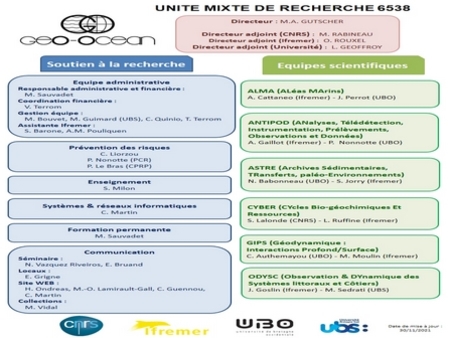UMR in brief
5 thematic research group
- Marine Hazards (ALMA)
- A. CAttaneo (Ifremer ; J. Y. Royer (CNRS)
- Sedimentary Archives, Transfers, Paleo-Environment (ASTRE)
- N. Babonneau (UBO) ; S. Jorry (Ifremer)
- Bio-Chemical Cycles and Resources (CYBER)
- S. Lalonde (CNRS) ; O. Rouxel (Ifremer)
- Geodynamics, Deep-surface Interactions (GIPS)
- C. Authemayou (UBO) ; P. Schnurle (Ifremer)
- Observation and Dynamics of Nearshore and Coastal Systemss (ODYSC)
- J. Goslin (Ifremer) ; M. Sedrati (UBS)
1 technology and methodology team
- Analyses, Remote sensing, Instrumentation, Sampling, Observation & Data (ANTIPOD)
- P. Nonnotte (UBO) ; A. Trinquier (Ifremer)
Geo-Ocean is six research groups all inter-related through their scientific projects and activities.
PAS - Plateforme d'Analyse Sédimentaire





